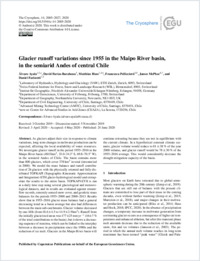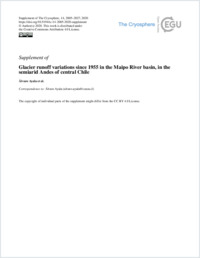Glacier runoff variations since 1955 in the Maipo River basin, in the semiarid Andes of central Chile
- Ayala, Álvaro Laboratory of Hydraulics, Hydrology and Glaciology (VAW), ETH Zurich, Zurich, 8093, Switzerland - Swiss Federal Institute for Forest, Snow and Landscape Research (WSL), Birmensdorf, 8903, Switzerland - Centre for Advanced Studies in Arid Zones (CEAZA), La Serena, 1720256, Chile
- Farías-Barahona, David Institut für Geographie, Friedrich-Alexander-Universität Erlangen-Nürnberg, Erlangen, 91058, Germany
- Huss, Matthias Laboratory of Hydraulics, Hydrology and Glaciology (VAW), ETH Zurich, Zurich, 8093, Switzerland - Swiss Federal Institute for Forest, Snow and Landscape Research (WSL), Birmensdorf, 8903, Switzerland - Department of Geosciences, University of Fribourg, Fribourg, 1700, Switzerland
- Pellicciotti, Francesca Swiss Federal Institute for Forest, Snow and Landscape Research (WSL), Birmensdorf, 8903, Switzerland - Department of Geography, Northumbria University, Newcastle, NE1 8ST, UK
- McPhee, James Department of Civil Engineering, University of Chile, Santiago, 8370449, Chile - Advanced Mining Technology Centre (AMTC), University of Chile, Santiago, 8370451, Chile
- Farinotti, Daniel Laboratory of Hydraulics, Hydrology and Glaciology (VAW), ETH Zurich, Zurich, 8093, Switzerland - Swiss Federal Institute for Forest, Snow and Landscape Research (WSL), Birmensdorf, 8903, Switzerland
-
24.06.2020
Published in:
- The Cryosphere. - 2020, vol. 14, no. 6, p. 2005–2027
English
As glaciers adjust their size in response to climate variations, long-term changes in meltwater production can be expected, affecting the local availability of water resources. We investigate glacier runoff in the period 1955–2016 in the Maipo River basin (4843 km2, 33.0–34.3∘ S, 69.8–70.5∘ W), in the semiarid Andes of Chile. The basin contains more than 800 glaciers, which cover 378 km2 in total (inventoried in 2000). We model the mass balance and runoff contribution of 26 glaciers with the physically oriented and fully distributed TOPKAPI (Topographic Kinematic Approximation and Integration)-ETH glacio-hydrological model and extrapolate the results to the entire basin. TOPKAPI-ETH is run at a daily time step using several glaciological and meteorological datasets, and its results are evaluated against streamflow records, remotely sensed snow cover, and geodetic mass balances for the periods 1955–2000 and 2000–2013. Results show that in 1955–2016 glacier mass balance had a general decreasing trend as a basin average but also had differences between the main sub-catchments. Glacier volume decreased by one-fifth (from 18.6±4.5 to 14.9±2.9 km3). Runoff from the initially glacierized areas was 177±25 mm yr−1 (16±7 % of the total contributions to the basin), but it shows a decreasing sequence of maxima, which can be linked to the interplay between a decrease in precipitation since the 1980s and the reduction of ice melt. Glaciers in the Maipo River basin will continue retreating because they are not in equilibrium with the current climate. In a hypothetical constant climate scenario, glacier volume would reduce to 81±38 % of the year 2000 volume, and glacier runoff would be 78±30 % of the 1955– 2016 average. This would considerably decrease the drought mitigation capacity of the basin.
- Faculty
- Faculté des sciences et de médecine
- Department
- Département de Géosciences
- Language
-
- English
- Classification
- Hydrology
- License
- License undefined
- Identifiers
-
- RERO DOC 328832
- DOI 10.5194/tc-14-2005-2020
- Persistent URL
- https://folia.unifr.ch/unifr/documents/308683
Other files
Statistics
Document views: 114
File downloads:
- hus_grv.pdf: 135
- hus_grv_sm.pdf: 143

